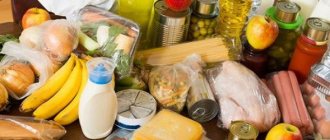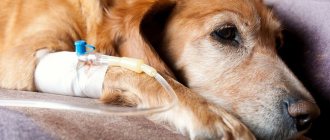Types of food poisoning
Food poisoning is an acute symptom that occurs in a person as a result of ingestion of poor quality food.
By nature, there are two large classes of food poisoning:
1. Poisoning by toxins from microbes in food. Such poisonings are also called food poisoning. They arise because microbes that inevitably get into food products, at the stage of their production or storage, begin to produce toxins over time. Non-pathogenic microbes in small quantities are quite safe for the body. The immune system will be able to cope with them. But the produced toxin can cause unpleasant symptoms.
Microbes produce toxin more actively if the storage temperature is violated. Hence the importance of storing food in the refrigerator rather than at room temperature. Especially in the heat.
Different foods produce toxins at different rates. Therefore, the expiration dates of products are different. And it is important to comply with them. Very quickly, microbes begin to produce toxins in dairy and meat products: custard, sour cream, minced meat. The more bacteria ingested into food, the more toxins they will produce. This is why cleanliness of production is so important. This also includes the prevention of bacterial infections among food production personnel.
Proper heat treatment of food is also important. If the temperatures are not high enough or the cooking time is too short, the microbes in the finished product are not killed. Chicken eggs are especially dangerous in this regard. It is unacceptable for children to prepare dishes from raw or half-raw eggs: eggnog, soft-boiled eggs or scrambled eggs with an uncooked yolk. Insufficiently processed meat products are unacceptable: undercooked cutlets, large pieces of meat.
Separately, it is worth mentioning canned food. If the production technology is violated or the integrity of the packaging is damaged, very dangerous gram-negative microbes can develop in them: clostridia. They cause a serious disease - botulism. Botulinum toxin primarily affects the nervous system, causing severe neurological disorders: severe muscle weakness, loss of acquired skills, weak crying, acute constipation, decreased breathing until it stops.
Children most often become infected with botulism by consuming honey. A large number of scientific articles are devoted to this problem, since throughout the world honey is considered a good remedy for the treatment of colds in children. The medical community agreed that honey is strictly prohibited for children under one year of age. Their stomach cannot produce enough acid to kill the clostridia spores. And should be taken with caution in preschool age.
2. Non-infectious or toxic poisoning. Poisons, chemical elements, inedible plants or mushrooms. Products contaminated with chemical elements, such as heavy metals, are rare in mass production. Raw materials at large factories are tested for quality. But the consumption of inedible things by children, especially young ones, is relatively common. Children can chew dangerous grass. For example, buttercup, datura or belladonna. Eat an inedible berry or mushroom.
Interpretation of child tests by pediatricians online
cost of service: 500 rubles
Order
The pediatrician will interpret the tests during an online call using the Zoom or WhatsApp application.
- detailed explanation from the pediatrician.
- an alternative opinion from a competent specialist in interpreting the analyses.
- the opportunity to ask questions to the doctor regarding test results.
Symptoms of food poisoning in a child
Symptoms of foodborne illness develop very quickly. From 30 minutes to 8 hours after consuming a spoiled product.
Symptoms that parents can identify:
- The most common symptom is nausea and vomiting. Vomiting may occur once or several times. Can be repetitive and exhausting;
- vomiting is followed by diarrhea. The stool becomes loose and frequent. Sometimes up to 10-15 times a day;
- Abdominal pain does not always occur with food poisoning. But sometimes they are very pronounced, cramping. Preschool children cannot clearly show the place where it hurts. They are usually shown in the navel area. Older children usually show the upper abdomen or just below. Due to the acute onset and severe pain, toxic infection can be confused with a surgical disease. Sometimes you can’t do without consulting a surgeon;
- fever is less common than vomiting, diarrhea and abdominal pain. Most often, the temperature does not rise above 37.5*C. Sometimes it reaches high numbers - 38.5 - 39 * C. But in case of poisoning it never lasts long. No longer than one or two days;
- pale skin, sometimes with blue around the eyes and mouth;
- cold sweat;
- the tongue is dry, with a white coating;
- pain in the upper abdomen when palpated;
- In addition, the child may be bothered by weakness, headache, and general malaise.
Vomiting and frequent loose stools are especially dangerous in children, because... they quickly develop symptoms of dehydration. Older children and adults usually experience symptoms of poisoning relatively easily and for a short time.
Symptoms that a doctor can identify:
- pulse slows down;
- heart sounds become muffled;
- In older children, the pressure will be slightly reduced.
It is especially important for mothers of children under one year old to know the symptoms of dehydration. If these symptoms appear, you need to provide first aid and show the baby to the doctor as quickly as possible.
Symptoms of severe dehydration:
- decreased frequency of urination compared to normal. Less than five times a day is a critical indicator;
- the tongue becomes dry and covered with a white coating;
- lips are cracking;
- skin is dry, pale, wrinkled;
- the large fontanelle sinks;
- the child is markedly lethargic, drowsy, lethargic;
- cries without tears or almost without tears.
Read more about dehydration in children in the article
“Dehydration in children. What should every parent know?
Things are somewhat more complicated with poisoning from poisonous plants. Symptoms of poisoning with herbs and mushrooms depend on the specific type of plant. It is not always possible for a mother to immediately understand what is happening to her child. There are plants that cause burns when they come into contact with mucous membranes. Such poisoning is easier to recognize. The child experiences acute pain almost immediately. The oral mucosa is swollen, bright red, sometimes with blisters and ulcers.
There are plants that will cause symptoms only some time after they enter the body. These may be gastrointestinal disorders: nausea, vomiting, diarrhea. Respiratory disorders: shortness of breath, difficulty or infrequent breathing. Cardiovascular: decreased heart rate and blood pressure. Neurological: convulsions, loss of consciousness, dizziness and headaches.
Separately, I would like to say about poisoning by plants containing alkaloids of the atropine group. These include belladonna, dope, scopolia, henbane, etc. Characteristic symptoms of poisoning by such plants will be: excitement, increased heart rate, increased blood pressure, dilated pupils.
Poisoning by chemical elements when eating food is rare. It is worth mentioning separately the cases when small children swallow household chemicals, soap, potassium permanganate, fabric softener, alcohol, vinegar and the like. Unfortunately, such poisonings are not at all uncommon. And they can lead to disastrous consequences. The mother of a small child should strictly ensure that potentially dangerous liquids are stored out of the reach of children.
Causes of fever, nausea and vomiting
Modern pediatrics indicates in many sources two reasons for the appearance of vomiting at a temperature of 37 degrees Celsius and above:
- the body gets rid of toxic substances;
- damage to the body by pathogenic bacteria, which leads to its destabilization.
These reasons are interconnected. Nausea makes itself felt against the background of a general painful condition. Only a qualified doctor can determine the exact cause of the problems after a thorough diagnosis.
Survey
In order for a doctor to diagnose food poisoning, as a rule, it is enough to carefully interview the parents and examine the child. Sometimes the doctor may additionally prescribe:
- a blood test to see if symptoms are caused by a bacterial or viral infection;
- stool analysis to rule out infection caused by abnormal bacteria;
- If an examination by a surgeon is required, he may also prescribe an additional examination.
Online consultation with pediatrician Olga Nikolaevna Tekutyeva
Registration online
During the consultation, you will be able to voice your problem, the doctor will clarify the situation, interpret the tests, answer your questions and give the necessary recommendations.
When is an increase in temperature dangerous?
High body temperature is an undoubted sign that some pathological process, usually of an inflammatory nature, is developing in the body. The higher the temperature, the faster it rises or the longer it lasts, the more serious the problem that caused it may be. This is why high temperatures are scary.
Meanwhile, in itself, an increase in temperature in most cases is a protective reaction to the penetration of infection. At high temperatures, the activity of pathogenic microorganisms decreases, and the body’s defenses, on the contrary, intensify: metabolism and blood circulation accelerate, and antibodies are released faster. But this increases the load on many organs and systems: cardiovascular, respiratory. High temperature depresses the nervous system and leads to dehydration. Possible circulatory disorders in internal organs (due to increased viscosity and blood clotting). Therefore, a high temperature that lasts for a long time can pose a danger in itself. Extremely high temperatures (above 41°C) are also dangerous.
What to do if your child has food poisoning
What to do if a child has food poisoning? First aid for moderate to severe food poisoning is gastric lavage. In children, it is better not to carry out this procedure on your own, but to seek help from specialists. Typically, washing is done with a solution of sodium bicarbonate or potassium permanganate until the wash water is clean.
It is strictly forbidden to wash the stomach of children under one year of age on their own. The child may choke. Children who have been poisoned by chemicals (alkalies or acids) and plants whose juice can cause burns should not be rinsed. When they pass through the digestive tract again, in the opposite direction, they will again damage the mucous membrane.
The next step in case of food poisoning, or in a situation where it is mild, is the use of adsorbents.
These are substances that collect toxins and poisons that enter the body on their surface. There are two basic rules for using such drugs. The medicine should be taken fractionally: often and in small portions. This way he will be able to collect the maximum amount of toxin.
The use of the adsorbent should be short-term. No longer than 4-5 days. Long-term use of such drugs in infants leads to excessive compaction of stool and the formation of fecal impaction. Diarrhea may give way to painful constipation.
A very important point in treatment is unsoldering a child, especially a small child. For infants, frequent breastfeeding and additional water are recommended. There are special solutions to replenish fluid loss. They are sold in the form of powders that are diluted with water. By consuming them, the child replenishes the loss of not only fluid, but also microelements and sugars. After 3 years, even drinking with plain water, weak tea, or compote is quite effective.
According to recent clinical studies, the use of antibiotics and antiseptics for toxic infections is not effective. During the recovery period, adherence to a diet is important - eating easily digestible food in small portions. Adding vitamins and microelements.
First aid for poisoning with chemicals and poisons should be carried out by specialists. In such cases, antidotes are used.
If botulism is suspected, doctors use antitoxic serum.
Treatment methods
Treatment tactics depend on the exact cause of poor health. The drugs should eliminate not only the symptoms, but also the causes of headache, nausea, vomiting, and high fever. Treatment can be carried out both at home and in a hospital, to allow round-the-clock monitoring of the patient.
- Antibiotic therapy is the main method of treating bacterial diseases and preventing purulent inflammation. Antibiotics are prescribed in the form of tablets or injections.
- Other drugs - the treatment regimen may include taking anti-inflammatory drugs, enterosorbents for disorders of the digestive tract, antispasmodics and drugs for correcting blood pressure.
- Diet is a necessary condition for poisoning, diseases of the stomach and intestines. The diet should not contain fatty foods, sweets, or fried foods, as they can provoke attacks of nausea, vomiting, and headaches.
- Surgical treatment is rarely prescribed. Surgery may be necessary for hematomas in the brain, tumors and other formations that interfere with normal blood circulation.
The Clinical Brain Institute offers comprehensive diagnostic and treatment programs for headaches that are accompanied by nausea, vomiting, and fever. Doctors warn that it is important not to self-medicate, but to contact specialists at the first signs of deterioration in health. Our center has modern, multifunctional equipment, and there is also the opportunity to undergo examinations by specialist and general doctors.
Possible consequences of food poisoning in children
As a rule, food poisoning, although it has clear symptoms, ends quickly and without consequences. Usually, by 3-4 days the child feels much better. In rare cases, young children may go into shock as a result of acute fluid loss. Children with severe underlying chronic pathology may develop severe inflammation.
Things are somewhat more complicated with poisoning by chemicals and poisons. If assistance is not provided in a timely manner or if there is a large amount of toxic substance, damage to the gastrointestinal tract, central nervous or cardiovascular system may persist. Their severity depends on many factors.
Botulism is a dangerous disease. According to modern literature, up to 10-20% of cases are fatal. Complications from the nervous system are common.
What is considered a high temperature?
Normal temperature is generally considered to be 36.6°C. But in fact, temperatures within a fairly wide range are normal.
During the day, body temperature fluctuates quite a bit. The lowest temperature is observed in the morning, immediately after waking up; maximum - in the evening, at the end of the day. The difference can be somewhere around 0.5°C. Physical activity, stress, ordinary meals, drinking alcohol, staying in a bathhouse or on the beach can raise the temperature. In women, temperature fluctuations are also associated with ovulation. A few days before ovulation, the temperature decreases, and when ovulation occurs, it increases.
On average, a normal temperature is considered to be between 35° and 37°C. In children under 3 years of age, a temperature of up to 37.5°C is also considered normal. Where you take your temperature matters. You can focus on 36.6°C if you place a thermometer under your arm. If the thermometer is held in the mouth ( oral temperature
), then the normal temperature will be 0.5°C higher (36.8-37.3°C).
In order to obtain normal values when measuring the temperature in the rectum ( rectal temperature
), you will need to add another half a degree (the norm is 37.3-37.7 ° C). Based on the measurement of the temperature under the arm, an elevated temperature is a temperature in the range of 37-38°C, a high temperature is above 38°C.
Worrying is either a temperature that rises above 38°C or a temperature of up to 38°C that persists for a long time ( low-grade fever
).
Possible causes of headache (with or without vomiting)
There are many factors that provoke headaches in children. Ailments may appear after sleep, in the morning or in the afternoon. Often their occurrence is associated with external factors: from weather changes to emotional or physical stress.
The following diseases cause pain in children:
- epilepsy;
- myositis;
- vasculitis (inflammation of the blood vessels of the brain);
- measles;
- migraine;
- vegetative-vascular dystonia;
- otitis;
- malignant or benign neoplasms;
- ARVI;
- sinusitis;
- pulpitis;
- neuroses;
- meningitis;
- periodontitis;
- angina;
- encephalitis;
- neuritis;
- and etc.
In addition, pain may occur in the event of toxic damage, poisoning, decreased or increased intracranial pressure. Another reason is the presence of head injuries. Source: https://www.ncbi.nlm.nih.gov/pmc/articles/PMC4293983/ Choon How How and Wei Shih Derrick Chan Headaches in children Singapore Med J. 2014 Mar; 55(3): 128–131.
Abdominal pain
Abdominal pain can have a variety of causes, from constipation to indigestion or the stomach flu. You should consult a doctor if the pain does not go away for a long time and is accompanied by a complete loss of appetite, greenish vomiting or diarrhea with blood. If the pain is so severe that the child cannot walk or doubles over, call a doctor immediately.
Pain above the belly button is often associated with digestive problems, indigestion, gas, or psychological anxiety (stress). Pain in the area below the navel may be due to a bladder infection. Constipation can cause severe pain in the left lower abdomen. Well, acute pain in the right side can be caused by appendicitis, and this is a reason to call a doctor.
Vomit
If your child starts vomiting, you should pause for about 30-40 minutes before giving him anything to drink. Then give the child a few small sips of simple clean water: boiled, filtered or mineral water without gas. If possible, go to the pharmacy and buy some saline solution (Gastrolit, Regidron, Humana-electrolyte). If vomiting does not recur after 15 minutes, continue to give water in increments every 15 minutes. Do not let your child eat for about 4 more hours. If the vomiting does not stop, the child may become extremely dehydrated. Therefore, in this case, be sure to call the pediatrician.
If vomiting does not stop for more than 24 hours, and especially if it is not accompanied by diarrhea, you should call an ambulance. Vomiting and fever in the absence of diarrhea can be signs of many dangerous diseases: appendicitis, streptococcal sore throat or urinary tract infection. If the vomit contains traces of blood or mucus, or the vomit is greenish in color, this may indicate an intestinal injury or obstruction and requires emergency medical attention.
Labored breathing
Difficulty breathing can be the cause of many diseases. Noisy or wheezing breathing is a sign of croup, an asthma attack, or an ingested foreign body. Croup is a respiratory illness most often accompanied by a barking cough that gets worse at night. Difficulty breathing with croup occurs when you inhale, but can be relieved by inhaling warm water vapor from a strong shower or cool outside air. Try to provide first aid and at the same time call a doctor. You should also consult a doctor if you experience any symptoms of difficulty breathing if it lasts more than 20-30 minutes.
Signs of bacterial meningitis
The main early symptoms of meningitis are fever, headache with vomiting, stiff neck with a tendency to throw the head back, and a red and sore throat. They usually occur after acute respiratory diseases of the airways.
In children under 2 years of age, meningitis usually leads to increased body temperature, lack of appetite, vomiting, irritability, and convulsions. The child cries constantly. The skin over the fontanel becomes tense and the fontanel may bulge. Unlike adolescents and adults, children in the first year of life do not always develop a stiff neck. Therefore, if a child experiences the symptoms described above, be sure to urgently call a pediatrician or an ambulance at home.









